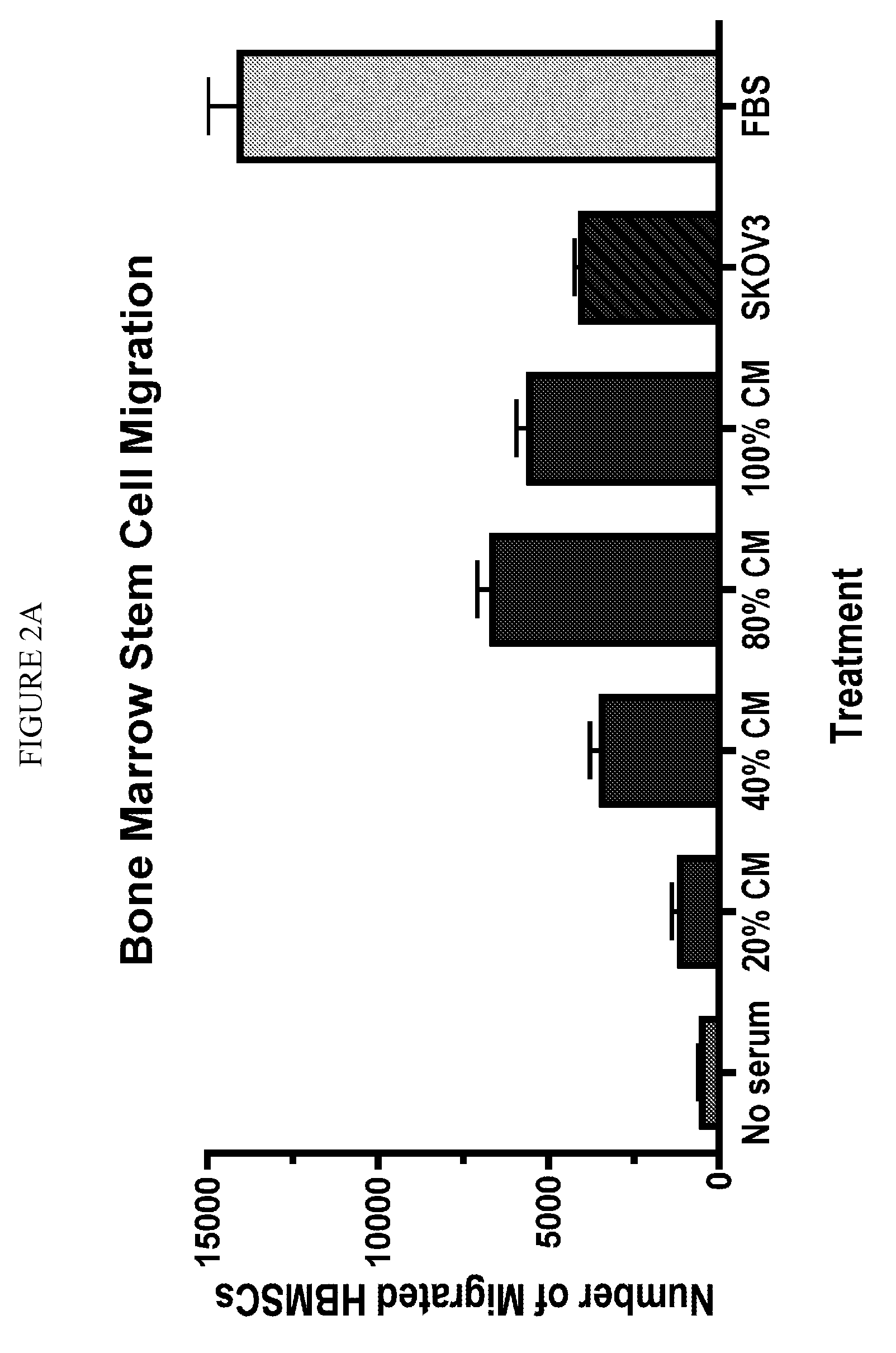Stem cell targeting of cancer, methods and compositions therefor
a technology of stem cells and cancer, applied in the field of stem cell targeting of cancer, methods and compositions therefor, can solve the problems of patient fatigue/malaise, cancer remains a significant health problem, toxic effects on normal tissues,
- Summary
- Abstract
- Description
- Claims
- Application Information
AI Technical Summary
Benefits of technology
Problems solved by technology
Method used
Image
Examples
example 1
[0030]This example illustrates establishment of human bone marrow stem cell (hBMSC) lines and ovarian cancer cell lines.
[0031]In these experiments, hBMSC lines from bone marrow aspirates were isolated. Briefly, stem cells were isolated from patient bone marrow aspirates using a ficoll gradient separation technique. Dr. Marc Katchen, Director of the Parkinson's Center, Department of Neurology, Methodist Medical Center, Peoria, Ill. provided the bone marrow aspirates. Dr. Darwin J. Prockop, Tulane Center for Gene Therapy, Tulane University Health Science Center, New Orleans, La., provided bone marrow mesenchymal stem cells. Following centrifugation, stem cells were removed, washed, concentrated and placed into culture at 37° C., in 5% CO2 and 9% O2. Cells were cultured in human complete culture medium (hCCM) consisting of DMEM (Invitrogen, Carlsbad, Calif.) with 16% fetal bovine serum (FBS, Hyclone, Logan, Utah), L-glutamine (200 mM, Sigma, St. Louis, Mo.), penicillin (100 Units / ml, I...
example 2
[0033]This example illustrates that human bone marrow stem cells migrate toward soluble factors in culture media.
[0034]To assess the chemotaxis response of stem cells in vitro, we used a modified Boyden chamber that consisted of upper and lower wells separated by a small matrigel-coated filter membrane with 8 μm pores. Human BMSCs were cultured to 50% confluence and harvested using trypsin. Cells were washed with sterile phosphate buffered saline, and 200 μl of hBMSCs (1×103) were diluted in hCCM with 16% FBS and added to the upper compartment of a Biocoat matrigel invasion chamber (BD Biosciences, San Jose, Calif.). A total of 750 μl of hCCM with or without 16% FBS was added to the lower chamber and the cells were incubated at 37° C., 5% CO2, 9% O2 for 48 hours. After incubation, the cells on the upper surface of the membrane were removed with a cotton tip applicator. Cells that had migrated through the membrane were fixed in 4% para-formaldehyde for 3 minutes, washed twice in PBS,...
example 3
[0035]This example illustrates that human bone marrow stem cells migrate to ovarian cancer multicellular tumor spheroids in vitro.
[0036]Compared to monolayer cultures, multicellular tumor spheroids (MCTS) may better model solid tumors. MCTS mimic the early small, avascular micrometastases of ovarian cancer observed in vivo. MCTS consist of three cell populations similar to that of microregions of solid tumors. These include cells that are actively dividing at the periphery, an intermediate population of quiescent, yet viable cells and a central, necrotic region (Kunz-Schughart and Muller-Klieser, 2000). Because of this, we examined whether hBMSCs preferentially migrate toward tumor spheroids. For generation of spheroids, Hey ovarian cancer cells (1×105 cells) were plated on 100 mm agarose-coated Petri dishes and cultured at 37° C., 5% CO2, 9% O2 for four days, avoiding any motion of dishes. On day three of culture, hBMSCs were labeled with 5-(6)-carboxyfluorescine diacetate, succini...
PUM
| Property | Measurement | Unit |
|---|---|---|
| diameter | aaaaa | aaaaa |
| outer diameter | aaaaa | aaaaa |
| magnetic resonance imaging | aaaaa | aaaaa |
Abstract
Description
Claims
Application Information
 Login to View More
Login to View More - R&D
- Intellectual Property
- Life Sciences
- Materials
- Tech Scout
- Unparalleled Data Quality
- Higher Quality Content
- 60% Fewer Hallucinations
Browse by: Latest US Patents, China's latest patents, Technical Efficacy Thesaurus, Application Domain, Technology Topic, Popular Technical Reports.
© 2025 PatSnap. All rights reserved.Legal|Privacy policy|Modern Slavery Act Transparency Statement|Sitemap|About US| Contact US: help@patsnap.com



